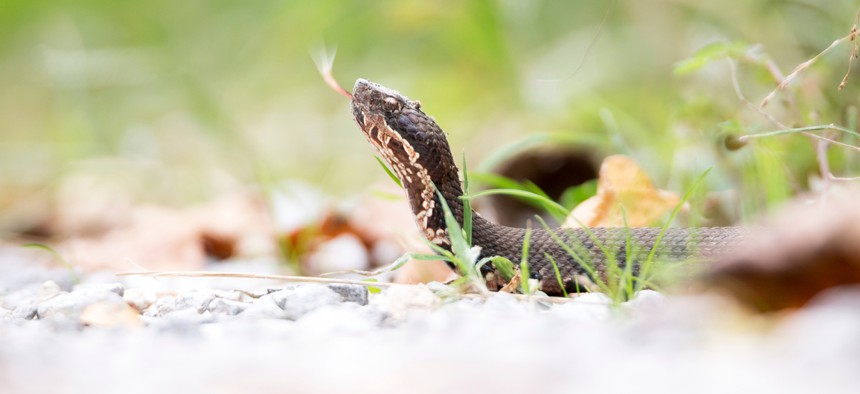Warm Weather Prompts Snake Warnings Throughout the U.S.

A cottonmouth snake in Wolf Lake, Illinois Shutterstock
The uptick in visible slithering reptiles has prompted cities and counties to warn residents that warmer weather and increased rainfall can force snakes out of their holes and into backyards, pools and homes.
Snake sightings have increased across much of the United States as both temperatures and rainfall kick into high gear ahead of summer.
The uptick in visible slithering reptiles—most of them non-venomous—has prompted cities and counties to warn residents that warmer weather and increased rainfall can force snakes out of their holes and into backyards, pools and homes.
“The more rain we get, the more snakes we are going to see,” Bob Cross, a snake expert in Florida, posted on Facebook alongside photos of the third venomous cottonmouth he captured in a two-week period. “Especially cottonmouth water moccasins which live around water, but they don’t live in water. No snake is going to stay in water constantly, they will seek higher dry ground.”
Drier climates may also see increased snake sightings, as warmer temperatures spur movement by waking snakes who hibernate through the winter.
"Right now with all of these warm temperatures, and plenty of moisture and abundance of food, they are out,” said Scott Cagle, an agent with the Mississippi State University Extension in Chickasaw County, Mississippi. “We had a very cold spring and now things are warming up, which means frogs and lizards and insects are crawling, and that's what snakes are looking forward to eating.”
The result is more snakes in public areas. In Rutherford County, North Carolina, a school resource officer found a “large black snake” near a walkway outside of Chase High School and relocated it to the woods with his bare hands.
In Huntersville, North Carolina, a stock-car racing team debated torching its headquarters after a long black snake coiled itself around the handles of the front door.
In Tampa Bay, trappers have been called to remove snakes from trees and, once, from a hole inside an aluminum bench outside of a Walmart. In Broward County, Florida, residents are arming themselves with “gardening tools, rakes and, at times, firearms,” in anticipation of encountering reptiles. That far south, warmer temperatures have also led to an increase in toxic toads, which pose a risk to curious pets who go in for a taste.
Most sightings have been benign, though some residents have suffered snake bites. In Wilson County, Texas, a copperhead snake bit a woman’s foot while she was working in her yard. In Colleton County, South Carolina, a man suffered two rattlesnake bites while kayaking.
But other snake sightings have been debunked. A Facebook post from an account purporting to represent Calhoun City, Georgia, warned residents that venomous snakes are loose in the municipal sewer system.
Calhoun Mayor James Palmer told the Associated Press that residents had asked him “whether it’s safe to walk the streets.”
The Facebook page included a disclaimer noting it’s a satire site, but sported the city’s official emblems and “appears official,” the mayor said. As of Thursday, the page appeared to have been taken down.
Kate Elizabeth Queram is a Staff Correspondent for Government Executive’s Route Fifty and is based in Washington, D.C.
NEXT STORY: Uber Irks Pittsburgh’s Mayor With Its Autonomous Vehicle Testing Announcement





